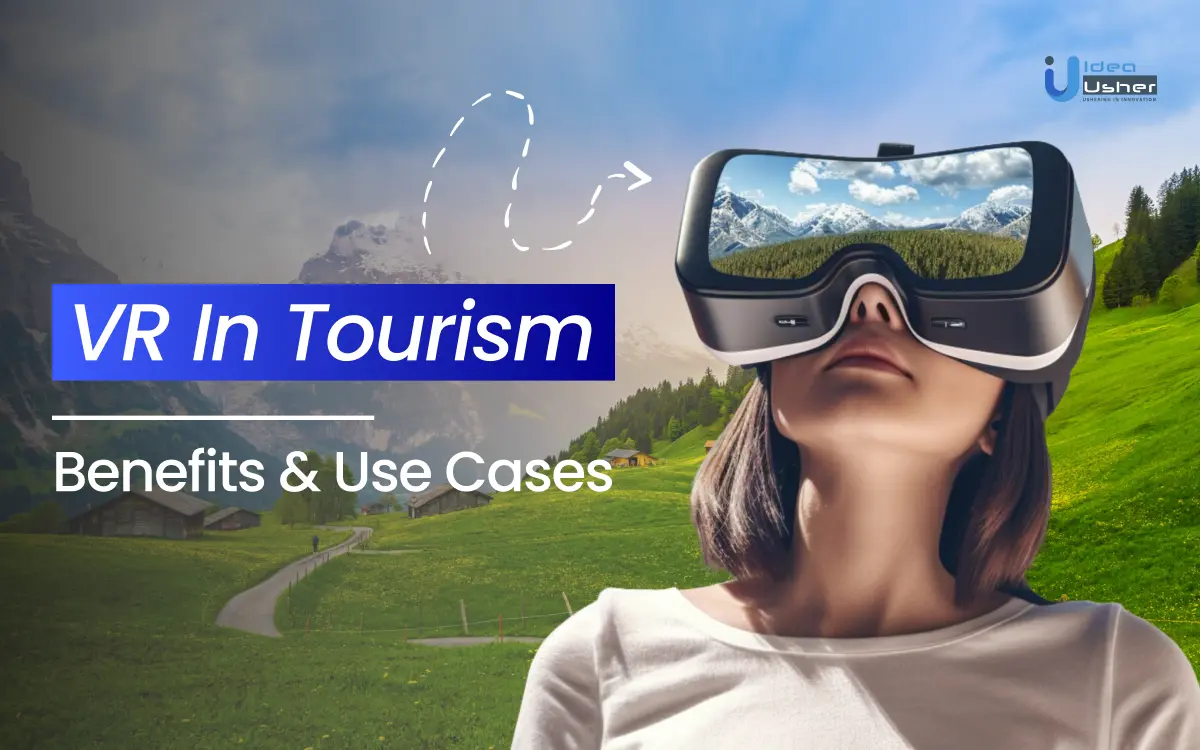Virtual reality in tourism provides viewers with an immersive tourism experience. There are many different types of virtual tourism services available. They use a combination of virtual reality, still images, video, audio, narration, and other multimedia formats.
Virtual tourism content can be accessed using a virtual reality headset for the most immersive experience. It can also be viewed on a regular computer or even a mobile device.
By using the power of VR technology, businesses can create immersive and accessible experiences that inspire curiosity, foster cultural understanding, and drive economic growth within the global tourism landscape.
In this article, we’ll explore into the world of VR applications in tourism, covering essential aspects such as key features, development processes, and cost estimation factors to understand how to effectively integrate VR into the tourism sector.
Market Stats For VR In Tourism
Virtual Reality (VR) technology is transforming the tourist business, providing immersive experiences that transport consumers to destinations across the world from the comfort of their own homes.
With advances in VR hardware and software, tourism businesses are using this technology to increase customer interaction and promote interest in tourist destinations like never before.

Source: Statista
The expanding global tourism market presents a lucrative opportunity for VR development in tourism.
As more travellers seek immersive experiences, VR offers a compelling solution to showcase destinations remotely. Capitalizing on this trend can lead to increased demand for VR content, driving growth and profitability in the tourism industry.
What Is Virtual Reality In Travel?
Virtual reality (VR) in travel entails the creation of interactive images or videos that allow viewers to explore a scene in full 360 degrees. Unlike traditional media captured from fixed viewpoints, VR technology captures every aspect of a location, providing a more immersive experience.
In the travel industry, VR is used to showcase tourism destinations in a unique and engaging manner. Specialized cameras, rigs, and software are employed to capture the content, which can then be experienced through VR headsets or on standard devices such as computers or mobile phones.
While some may believe that VR content is exclusive to dedicated VR headsets, it can actually be accessed on any device, offering varying levels of immersion. For instance, at Immersion VR, we produce tourism VR content that can be explored by clicking or swiping across the video to view the entire 360-degree environment.
Benefits Of Virtual Reality In Tourism
Virtual reality (VR) has revolutionized the tourism industry by offering immersive experiences that transcend physical limitations. From virtual tours of destinations to interactive cultural explorations, VR enhances travel planning and fosters global connectivity.
1. Immersive Destination Experience
Virtual reality (VR) offers a unique and immersive way for users to experience travel destinations without physically being there. By transporting users to different locations, VR allows them to vividly imagine themselves at a travel destination, fostering a sense of connection and anticipation.
2. Detailed Destination Showcase
One of the key advantages of VR in tourism is its ability to showcase destinations in stunning detail. Through high-resolution, 360-degree views, users can explore every angle of a destination, providing them with a comprehensive understanding of what it has to offer.
3. Flexible Exploration
Moreover, VR empowers users to navigate and explore scenes at their own pace and according to their preferences. This flexibility enhances the user experience, allowing individuals to tailor their virtual journey to their interests and desires.
4. Memorable Interactions
In addition to offering immersive experiences, VR in tourism creates memorable and unique interactions for users. By simulating real-world environments and activities, VR can evoke strong emotions and leave a lasting impression on users, making their virtual travel experiences truly unforgettable.
5. Innovative Brand Engagement
From a marketing perspective, VR enables travel companies to differentiate themselves and engage with consumers in innovative ways. By leveraging VR technology, companies can create distinctive brand experiences that capture the attention of potential travelers and set themselves apart from competitors.
6. Accessibility Enhancement
Furthermore, VR has the potential to make travel accessible to individuals who may face limitations or barriers to traditional forms of tourism. Whether due to physical disabilities, financial constraints, or other reasons, VR can provide these individuals with the opportunity to explore destinations and cultures from the comfort of their own surroundings.
7. Sustainability Contribution
Importantly, VR in tourism can also contribute to sustainable travel practices by reducing the environmental impact of traditional tourism activities. By offering virtual alternatives to physical travel, VR can help minimize overcrowding and mitigate the negative effects of tourism on vulnerable destinations and ecosystems.
VR Trends For The Virtual Travel Industry
Virtual reality (VR) travel trends have surged in popularity, with travel companies actively offering immersive VR experiences to their customers. These experiences often include simulated journeys to various destinations, allowing users to explore different places from the comfort of their own homes.
1. VR Travel Experiences by Travel Companies
Virtual reality (VR) travel trends have surged in popularity, with travel companies actively offering immersive VR experiences to their customers. These experiences often include simulated journeys to various destinations, allowing users to explore different places from the comfort of their own homes.
2. Virtual Hotel Tours by Travel Companies and Hotels
Both travel companies and hotels are increasingly providing virtual tours of their accommodations, giving potential guests a detailed preview of their facilities and amenities before making a booking decision.
3. Technologies to Make VR Travel More Realistic
To enhance the realism of VR travel, ongoing advancements in technology are being implemented. These innovations aim to replicate the sights, sounds, and even sensations of being in a particular location, thus providing users with a more authentic and immersive experience.
4. VR Travel Experiences for the Elderly
Recognizing the potential of VR technology to cater to diverse demographics, there is a growing focus on creating VR travel experiences specifically tailored to the elderly population. These experiences are designed to cater to the unique needs and preferences of older individuals, offering them opportunities to virtually explore destinations they may not have been able to visit physically.
5. VR Flight Experiences
VR flight experiences have gained traction as a novel way for users to virtually experience air travel. These simulations allow users to immerse themselves in the entire flight process, from boarding to landing, providing a realistic portrayal of the flying experience without leaving the ground.
6. Virtual Experiences of Landmark Destinations
Another popular trend in VR travel is the creation of virtual experiences of landmark destinations. Users can virtually visit iconic landmarks and tourist attractions worldwide, gaining insights into their history, significance, and architectural marvels through immersive VR environments.
7. Virtual Booking Interface
Moreover, the development of virtual booking interfaces simplifies the process of planning and booking travel experiences within the VR environment. These interfaces enable users to browse destinations, view accommodations, and make bookings seamlessly, all within the immersive VR environment, enhancing the overall convenience and accessibility of VR travel.
Use Cases Of Virtual Reality In Tourism
Virtual reality (VR) is revolutionizing tourism by offering immersive experiences that allow travelers to explore destinations, engage in cultural activities, and preview accommodations, enhancing trip planning and the overall tourist experience. Here are some of the use cases
1. Virtual Destination Exploration
Through virtual reality (VR), prospective tourists can engage in comprehensive exploration of various destinations. This technology offers detailed virtual tours of landmarks, museums, or natural wonders, presenting a 360-degree immersive experience. By virtually visiting these locations, travelers can gather information, assess the appeal of destinations, and plan their trips more effectively.
2. Virtual Travel Experiences
VR technology transports users into diverse travel experiences, from iconic activities like riding a gondola in Venice to adventurous endeavors like hiking through a rainforest or even encountering wildlife like swimming with dolphins. These simulated adventures provide travelers with a taste of different cultures and environments, sparking their interest in exploring new destinations and embarking on unique experiences.
3. Virtual Hotel and Accommodation Tours
Hotels and resorts leverage VR to offer detailed virtual tours of their accommodations. Prospective guests can virtually explore various room types, amenities, and facilities, gaining a realistic sense of the lodging options available. This immersive experience empowers travelers to make well-informed decisions about their accommodations, leading to increased bookings for hospitality businesses.
4. Virtual Historical Reconstructions
VR technology enables the recreation of historical sites and events, providing tourists with immersive experiences of significant moments in history. By virtually stepping into the past, visitors can gain a deeper understanding of historical contexts, civilizations, and cultures. These immersive reconstructions enrich educational tourism, offering insights into diverse historical periods and fostering cultural appreciation.
5. Virtual Cultural Immersion
Cultural institutions and tourism organizations utilize VR to offer immersive cultural experiences to audiences worldwide. Through virtual platforms, users can participate in virtual festivals, ceremonies, or cultural performances, immersing themselves in the traditions and customs of different societies. This virtual cultural immersion fosters cross-cultural understanding and appreciation, promoting cultural exchange and dialogue.
6. Virtual Reality Travel Agencies
Modern travel agencies integrate VR technology into their services, offering virtual consultations and immersive presentations to clients. Through VR platforms, travelers can preview destinations, activities, and accommodations in a highly immersive manner. These virtual experiences enhance the booking process, enabling travelers to make informed decisions and tailor their travel experiences according to their preferences.
7. Virtual Tour Guide Services
VR-based tour guide services provide personalized, immersive tours led by virtual guides. Travelers can interact with these virtual guides, who offer informative commentary, historical facts, and navigation assistance throughout the virtual tour. This interactive experience enhances the overall tourist experience, providing travelers with insightful guidance and enriching their exploration of destinations.
Examples Of Virtual Reality In Tourism
Discover the world from the comfort of your home with virtual reality tourism. Explore stunning destinations like the Faroe Islands, Bristol, Dubai, and the Great Barrier Reef in immersive experiences
1. The Faroe Islands
Situated off the coast of Iceland, the Faroe Islands are a picturesque group of islands. With the onset of the COVID-19 pandemic, the Faroe Islands introduced a virtual tourism campaign as an alternative to physical travel. This initiative proved to be a boon for individuals worldwide who were confined due to isolation measures. It allows virtual visitors to explore the islands through the perspective of a local, offering real-time tracking of local activities.
2. Bristol From Home
In response to the pandemic, Visit Bristol developed an immersive virtual experience called Bristol From Home, mirroring the Faroe Islands’ approach. This platform compiles various attractions, activities, and resources that travelers can enjoy from the comfort of their homes during social distancing. The website offers an array of virtual tours, including visits to a luxury Victorian ship, virtual hot-air balloon rides, gin tastings, and more, providing a comprehensive virtual exploration of Bristol’s offerings.
3. Dubai 360: A Virtual Tour of Dubai
Dubai 360 offers an immersive virtual tourism experience showcasing the awe-inspiring architecture of Dubai. This platform allows users to navigate the city from a bird’s-eye view, providing comprehensive information about its diverse attractions and landmarks.
4. The Great Barrier Reef
Virtual tourism is also available for the Great Barrier Reef, offering an interactive journey hosted by renowned broadcaster and historian David Attenborough. This virtual experience provides viewers with a comprehensive tour of the world’s largest coral reef system. It serves as more than just a substitute for physical tours of the Great Barrier Reef, offering a unique and versatile exploration of this natural wonder.
How To Develop A VR App For Travel Industry?
Developing a VR app for the virtual travel industry involves a blend of technical expertise, creative design, and a deep understanding of user experience. Below are non-generic steps to guide you through the process:
1. Market Research and Conceptualization
Identify your target audience within the virtual travel industry, such as adventure seekers, travel enthusiasts, or those with limited mobility. Understand the current market trends by analyzing existing VR travel apps and identifying potential gaps or opportunities for innovation.
2. Define User Experience (UX) and User Interface (UI):
Develop user personas based on thorough research to understand your target audience’s demographics, behaviors, and preferences. Tailor the UX/UI design accordingly to ensure a seamless and immersive experience for users navigating the virtual travel app. Create wireframes and mockups to visualize the app’s layout, navigation flow, and overall look, prioritizing intuitive controls and seamless transitions to enhance user immersion and comfort within the virtual environment.
3. Choose VR Development Tools and Platforms
Select appropriate VR development platforms based on your target VR devices, considering factors such as Oculus Rift, HTC Vive, PlayStation VR, or mobile VR platforms like Oculus Quest. Utilize game engines like Unity or Unreal Engine known for their VR capabilities, along with VR-specific SDKs and frameworks. Consider compatibility with additional peripherals like motion controllers or haptic feedback devices to enhance user interaction and immersion within the virtual travel experiences.
4. Content Creation and Integration
Curate high-quality 360-degree videos or immersive VR environments showcasing various travel destinations. Utilize photogrammetry techniques to create realistic 3D models of landmarks, cities, or natural landscapes. Integrate interactive elements such as informational hotspots, guided tours, or mini-games to engage users during their virtual travel experiences, ensuring that the content is both captivating and informative for users exploring different destinations within the app.
5. Implement Social and Sharing Features
Enable multiplayer functionality to allow users to explore virtual destinations together or share experiences in real-time, fostering social interactions within the virtual travel app. Integrate social media sharing options to enable users to share snapshots or videos of their virtual travels with friends and family, expanding the app’s reach and user engagement.
6. Optimize Performance and Accessibility
Optimize graphics rendering and resource management to ensure smooth performance across different VR hardware specifications, providing users with a seamless and immersive experience regardless of their device. Implement accessibility features such as adjustable text sizes, voice commands, or alternative control schemes to accommodate users with disabilities, ensuring that the app is inclusive and accessible to all users.
7. Monetization and Business Model
Explore various monetization strategies such as premium app purchases, subscription models, in-app purchases for virtual souvenirs or upgrades, or sponsored content partnerships with travel brands. Consider offering a freemium model with basic features accessible for free and premium content or experiences available through in-app purchases or subscription tiers, providing users with flexibility and choice in how they access and enjoy the virtual travel app’s offerings.
8. Launch, Marketing, and User Feedback
Plan a strategic launch campaign targeting VR enthusiasts, travel communities, and tech media outlets to generate buzz and excitement around the virtual travel app. Gather user feedback through beta testing phases, user surveys, and app analytics to iteratively improve the app’s features and performance post-launch, ensuring that it meets the evolving needs and expectations of its users.
Cost Affecting Factors To Consider To Develop A VR Based Travel App
Developing a VR-based travel app involves several cost-affecting factors that need careful consideration. Each of these elements contributes to the overall expense of creating the app, and it’s essential to allocate resources accordingly to ensure a high-quality product.
1. Development Cost
The development of a VR-based travel app involves several cost factors, including software development, UI/UX design, and testing. Allocating resources effectively in this phase ensures the creation of a high-quality product that meets user expectations.
2. Content Creation Cost
A crucial aspect of VR travel apps is content creation, which includes producing 360-degree videos and virtual tours. Quality and quantity of content directly impact user engagement, necessitating thorough budgeting to ensure immersive experiences.
3. Integration with VR Hardware
Ensuring compatibility with various VR devices and platforms adds complexity to development and may incur additional expenses. Seamless integration and optimal performance across hardware configurations are essential for a consistent user experience which can be easily done by hiring VR developers.
4. Marketing and Promotion
Effective marketing campaigns, advertising, and promotional activities are vital for garnering visibility and attracting users. Strategic budget allocation in this area significantly impacts user acquisition and retention, contributing to the app’s success.
5. Maintenance and Updates
Regular maintenance, bug fixes, feature enhancements, and software updates are essential for sustaining the app’s functionality and relevance. Budgeting for ongoing maintenance tasks ensures the app remains secure and up-to-date with evolving technologies and user preferences.
Know more about the cost of VR app development in detail with this ultimate guide.
Here is detailed breakdown of estimated cost to develop a VR powered travel app:
| Factors | Estimated Cost |
| Development Cost | $80,000 – $100,000 |
| Content Creation Cost (360-degree videos and virtual tours) | $45,000 – $50,000 |
| Integration with VR Hardware | $15,000- $20,000 |
| Marketing and Promotion | $25,000 – 30,000 |
| Maintenance and Updates | $10,000 – $15,000 |
Tech Stack To Consider To Develop A VR Based Travel App
Developing a virtual reality (VR) based virtual travel app requires careful consideration of various technologies to ensure a seamless and immersive user experience. Here’s a suggested tech stack you can consider:
1. Unity or Unreal Engine
These are popular game engines commonly used for developing VR applications. Both engines support VR development and offer robust tools and features for creating immersive environments.
2. VR Headsets
Determine which VR platforms you want to target and choose the appropriate headsets. Common options include Oculus Rift, HTC Vive, Oculus Quest, and Valve Index. Each has its SDK and development requirements.
3. 3D Modeling and Animation Software
Tools like Blender, Autodesk Maya, or Cinema 4D are essential for creating 3D models, environments, and animations for your VR travel app.
4. Programming Languages
Depending on the game engine chosen, you’ll need to be familiar with programming languages such as C# for Unity or C++ for Unreal Engine.
5. VR SDKs
Utilize VR software development kits (SDKs) provided by headset manufacturers like Oculus SDK, SteamVR SDK, or OpenVR for integrating VR-specific features into your app.
6. Spatial Audio Libraries
Implement spatial audio to enhance the immersive experience. Libraries like Google Resonance Audio or Oculus Spatializer can help achieve realistic audio effects.
7. Networking
If you want to include multiplayer or social features in your app, you’ll need networking capabilities. Libraries like Photon Unity Networking (PUN) or Mirror can facilitate multiplayer functionality.
8. Backend Development
For user authentication, data storage, and content management, you may need a backend server. Technologies like Node.js, Django, or Firebase can be used for backend development.
9. Cloud Services
Consider cloud services like AWS or Azure for hosting your backend infrastructure and managing scalability and performance.
10. UI/UX Design Tools
Design intuitive user interfaces and user experiences using tools like Adobe XD, Sketch, or Figma. VR-specific considerations such as user comfort and interaction design are crucial.
11. Analytics and Monitoring
Integrate analytics tools like Google Analytics or Firebase Analytics to track user behavior, engagement, and performance metrics within your VR app.
12. Testing Tools
Ensure the quality of your VR app with testing tools like Unity Test Framework, Oculus Performance Profiler, or SteamVR Performance Test to optimize performance and identify bugs.
13. Security
Implement security measures to protect user data and ensure a secure VR experience. Consider encryption, secure authentication methods, and compliance with data protection regulations.
14. Deployment Platforms
Decide where you want to distribute your VR app. Options include app stores like Oculus Store, SteamVR, or standalone distribution platforms if you’re targeting enterprise users.
Conclusion
Virtual tours offer a promising avenue for diversifying tourism, they provide an accessible option for individuals who may lack the resources, finances, or time to engage in traditional travel experiences.
Moreover, virtual tours present a cost-effective way to showcase tourist destinations to both local and central governments, requiring advancements in technology such as 360-degree software, virtual reality (VR), and panoramic imaging.
The evolution of these technologies has enabled the creation of immersive 3D virtual tours, enhancing their realism and appeal.
By leveraging these technological advancements, virtual tours can serve as compelling previews that encourage physical visits to tourist attractions, bridging the gap between virtual and in-person experiences.
How Can We Help In Developing A VR Based Virtual Travel App?
We specialize in creating advanced AI solutions and are skilled in developing VR-based virtual travel applications.
Our talented team of developers and engineers is ready to use cutting-edge technology to create a flawless and immersive virtual travel experience.
We’re available to work together on anything from developing the initial idea to executing the final deployment. Contact us today by using the button below to begin your VR app development journey.
Work with Ex-MAANG developers to build next-gen apps schedule your consultation now
FAQ
Q. How can VR technology benefit tourism business?
A. Virtual Reality offers immersive experiences that can showcase your destinations, accommodations, and activities in a way that traditional media cannot. It allows potential customers to virtually explore your offerings, increasing engagement and driving bookings.
Q. What are the key use cases of VR in the tourism industry?
A. VR can be used for virtual tours of hotels, resorts, and attractions, providing potential guests with a realistic preview of their experience. It’s also valuable for destination marketing, allowing travelers to virtually explore destinations before making travel decisions. Additionally, VR experiences can enhance travel agency presentations and trade show exhibits, offering a unique and memorable way to showcase destinations.
Q. How difficult is it to integrate VR into existing business operations?
A. Integrating VR into your business can vary in complexity depending on your specific needs and resources. There are off-the-shelf VR solutions available for creating virtual tours and experiences, which can be relatively easy to implement with the right guidance. However, for more customized VR experiences, you may need to work with VR developers or agencies to create content tailored to your business.
Q. Will investing in VR technology provide a good return on investment (ROI) for my tourism business?
A. While the initial investment in VR technology may seem significant, it can lead to long-term benefits such as increased bookings, improved customer engagement, and enhanced brand reputation. By offering immersive experiences that differentiate your business from competitors, VR has the potential to attract more customers and generate higher revenue over time.
Q. How can VR experiences enhance customer satisfaction and loyalty?
A. VR experiences can provide customers with a realistic preview of their travel experiences, helping to manage their expectations and reduce the likelihood of disappointment upon arrival. By offering immersive and interactive content, you can also create memorable experiences that increase customer satisfaction and encourage repeat visits or referrals.
Q. Are there any limitations or challenges associated with implementing VR in the tourism industry?
A. While VR technology offers many benefits, there are some challenges to consider, such as the initial cost of equipment and content creation, technical requirements for hosting VR experiences, and ensuring accessibility for all users. Additionally, VR experiences may not fully replicate the sensory richness of real-world travel, so it’s important to manage customer expectations and supplement VR with other marketing efforts.






















